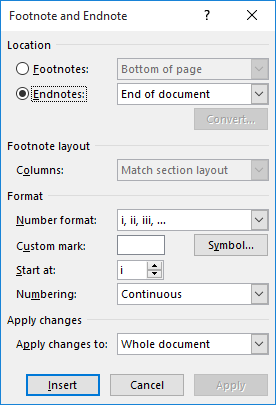Please Note: This article is written for users of the following Microsoft Word versions: 2007, 2010, 2013, 2016, 2019, 2021, and Word in Microsoft 365. If you are using an earlier version (Word 2003 or earlier), this tip may not work for you. For a version of this tip written specifically for earlier versions of Word, click here: Default Numbering Format for Endnotes.
Written by Allen Wyatt (last updated June 3, 2023)
This tip applies to Word 2007, 2010, 2013, 2016, 2019, 2021, and Word in Microsoft 365
Ken wonders if it is possible to change the default numbering format for endnotes from lowercase Roman numerals (i, ii, etc.) to uppercase Roman numerals (I, II, etc.). While this can be done manually in the Insert Endnote dialog box, that takes several steps and a change to the default would be much easier and faster.
It is possible to change the default, but the way you do it is to change the template on which new documents are based. In most cases, this means changing the Normal template because most new documents are based, automatically, on settings stored in the Normal template. (In other words, changing the template is how you change many of Word's defaults—including endnote numbering styles.)
In order to make a change to the Normal template you need to load it directly. The location of the Normal template will vary from system to system, but you can use the Windows search feature to locate it. (Just search for Normal.dotx, Normal.dotm, or some variation of these names.) Load the template directly into Word and then follow these steps:

Figure 1. The Footnote and Endnote dialog box.
The next time you create a document based on that template, the endnote reference numbers will be formatted as Roman numerals (assuming you selected a Roman numeral format in step 3). This won't affect any existing documents, only new ones.
WordTips is your source for cost-effective Microsoft Word training. (Microsoft Word is the most popular word processing software in the world.) This tip (5936) applies to Microsoft Word 2007, 2010, 2013, 2016, 2019, 2021, and Word in Microsoft 365. You can find a version of this tip for the older menu interface of Word here: Default Numbering Format for Endnotes.

Create Custom Apps with VBA! Discover how to extend the capabilities of Office 365 applications with VBA programming. Written in clear terms and understandable language, the book includes systematic tutorials and contains both intermediate and advanced content for experienced VB developers. Designed to be comprehensive, the book addresses not just one Office application, but the entire Office suite. Check out Mastering VBA for Microsoft Office 365 today!
Endnotes are easy enough to add and accumulate in a document. For this reason, Word makes it easy to jump from one ...
Discover MoreEndnotes appear at either the end of a section or the end of an entire document. It is just as easy to insert an endnote ...
Discover MoreEndnotes are indispensable in some types of writing. You may want to create endnotes, however, that don't follow the ...
Discover MoreFREE SERVICE: Get tips like this every week in WordTips, a free productivity newsletter. Enter your address and click "Subscribe."
There are currently no comments for this tip. (Be the first to leave your comment—just use the simple form above!)
Got a version of Word that uses the ribbon interface (Word 2007 or later)? This site is for you! If you use an earlier version of Word, visit our WordTips site focusing on the menu interface.
Visit the WordTips channel on YouTube
FREE SERVICE: Get tips like this every week in WordTips, a free productivity newsletter. Enter your address and click "Subscribe."
Copyright © 2025 Sharon Parq Associates, Inc.
Comments